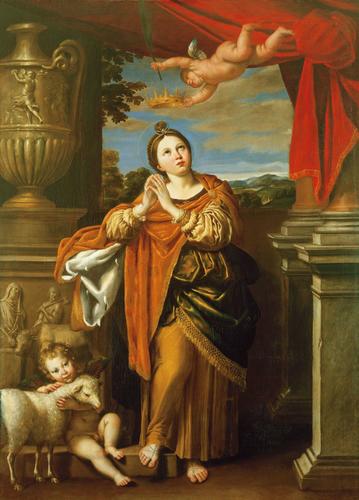-
1 of 253523 objects
Saint Agnes c.1620
Oil on canvas | 212.7 x 152.4 cm (support, canvas/panel/stretcher external) | RCIN 404982
-
In 1605 the remains of the fourth-century martyr St Agnes were discovered in Rome. Domenichino shows the saint gazing heavenwards while an angel holds a crown and martyr’s palm above her. The large classical vase and relief sculpture signify the pagan beliefs she has rejected; the lamb (agnus in Latin) refers to her purity and name.
Domenichino’s early period in Rome coincided with a significant discovery in the city. In 1605, during the course of the remodelling of the Roman basilica of Sant’ Agnese Fuori le Mura under Cardinal Sfondrato, the remains of the fourth-century martyr St Agnes were discovered. Agnes had been condemned to death by the Roman Emperor for her unwavering adherence to the Christian faith; despite her tormentors’ initial attempts to kill her, she miraculously remained unharmed until she was finally (and successfully) beheaded. The present painting fits within the climate of renewed interest in the cult of St Agnes, the virgin martyr, which flourished in Rome at this time, encouraged by Cardinal Sfondrato and Pope Paul V.
Domenichino represents the saint standing and gazing heavenward as an angel holding a palm and a crown floats above her. Pentiments are clearly visible in the head and the hands of the saint where the artist made slight changes to their position. On the left-hand side the large classical vase and low-relief sculpture signify the pagan beliefs rejected by the saint; in contrast, a small putto in the foreground embraces a lamb, her attribute (from the Latin, agnus) and a symbol of innocence and purity.
Evidence for the carefully modelled quality of the putto and the lamb is found in a preparatory chalk drawing for the painting held in Windsor Castle. The other side of this sheet contains a study for another Domenichino altarpiece, similar in style: the Madonna del Rosario (Pinacoteca Nazionale, Bologna), completed in Rome in the early 1620s. Since Domenichino does not seem to have worked on the same sheets at different periods in his career, scholars have generally accepted the existence of preparatory drawings for both the St Agnes and the Madonna del Rosario on a single sheet as persuasive evidence supporting a dating of the two works to the same period. The significance of St Agnes in Rome may indicate a dating of the work to the period immediately following the artist’s return to the papal city in 1621. A characteristically vibrant and rich colour palette, fluid drapery, and carefully studied figural types, unify the artist’s work of this period; the work holds stylistic affinities to paintings such as the altarpiece of the Martyrdom of St Agnes (Pinacoteca Nazionale, Bologna).
Domenichino’s debt to earlier painters is particularly evident in the figure of St Agnes, which recalls the central figure in Raphael’s painted altarpiece of Saint Cecilia with Four Saints (Pinacoteca Nazionale, Bologna). Painted for the Bolognese church of San Giovanni in Monte, this was studied by the Carracci and their followers and would have been well known to Domenichino. Notably, Domenichino also draws upon the art of Titian: the figure of the angel holding the crown and palm shows the influence of the Venetian artist’s Worship of Venus (1518; Prado). This painting and its companion, The Bacchanal (c.1518; Prado), were in the possession of the Aldobrandini family; a now lost study by Domenichino of The Bacchanal attests to the artist’s intimate knowledge of this significant Roman collection.
The painting appears in Pyne's illustrated Royal Residences of 1819, hanging in the Crimson Drawing Room at Buckingham Palace (RCIN 922142).
Catalogue entry adapted from The Art of Italy in the Royal Collection: Renaissance and Baroque, London, 2007Provenance
Possibly acquired by Charles I from the Gonzaga collection, Mantua, in 1628-32; sold to Wagstaff for £25 from St James's Palace on 16 July 1650 (no 257); recovered at the Restoration; seen by Monconys on 20 May 1663 in the Duchess of York's apartments at St James's Palace and listed there in the Queen's Bedchamber in 1688 (no 1221)
-
Creator(s)
-
Medium and techniques
Oil on canvas
Measurements
212.7 x 152.4 cm (support, canvas/panel/stretcher external)
246.8 x 190.0 x 7.1 cm (frame, external)
Category
Object type(s)
